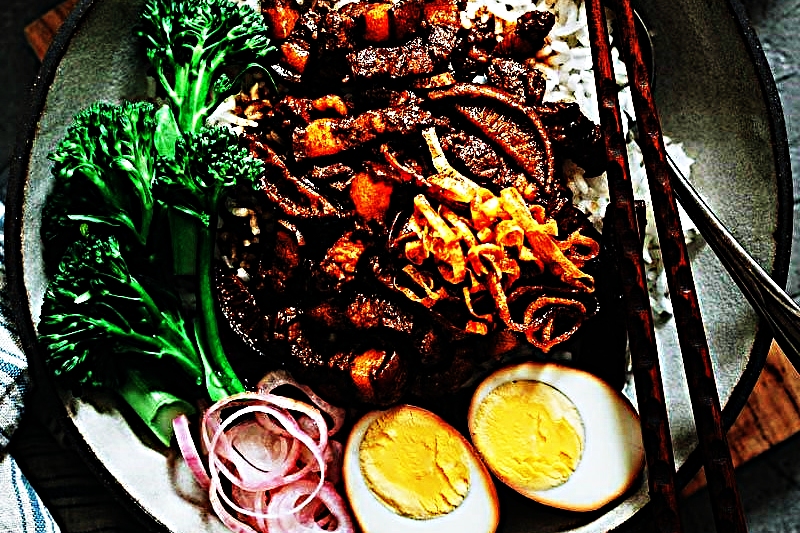Take your taste buds to Taiwan with the classic one-bowl Lu Rou Fan: a dish of tender-braised pork belly with a rich and savory gravy, eggs, and veggies over steamed rice.
Satisfy your sweet tooth with this easy-to-make recipe for Lu Rou Fan (Taiwanses Pork Rice Bowl).
1. Info for Lu Rou Fan (Taiwanses Pork Rice Bowl)
- Cook Time: 1 hr 50 min
- Total Time: 1 hr 50 min
- Servings: 4
2. Ingredients for Lu Rou Fan (Taiwanses Pork Rice Bowl)
- 8 dried shiitake mushrooms
- 1 lb pork belly (skin-on, cut into thin strips)
- 2 teaspoons Shaoxing wine (or dry sherry)
- 1 teaspoon dark soy sauce
- Crispy Shallots (or 1/4 cup Thai fried onion/shallot)
- 1 large shallot (sliced into 1/4” rounds)
- 2 cloves garlic (sliced)
- 1/2 cup vegetable oil
- 2 tablespoons Shaoxing wine (or dry sherry)
- 2 tablespoons soy sauce
- 1 tablespoon dark soy sauce
- 1 tablespoon rock sugar (or white sugar)
- 2 star anise pods
- 1 cinnamon stick
- 4 hard boiled eggs
- Green veggies
- pickled shallots
- Steamed rice
3. Directions:
- Add the dried shiitake mushrooms into a small bowl and pour in 1 cup of boiling water. Rehydrate for at least 20 minutes, or until the mushrooms turn tender throughout. Once rehydrated, remove the shiitakes from their soaking liquid, squeezing out the extra water. Slice them into 3/4”(1 cm) strips. Reserve the soaking liquid.
- Cut the pork belly into thin slices, about 1/4”(1/2 cm) thick. Then cut into thin strips, about 1/4” (1/2 cm) thick. Transfer the pork belly into a medium-sized bowl. Add 2 tsp Shaoxing wine and 1 tsp dark soy sauce. Mix well. Let marinate for 20 to 30 minutes.
- Fry the shallots (Optional, skip this step if using pre-fried shallots): While the pork is marinating, heat a 9” cast iron pan (or heavy-bottomed pan) over medium-low heat and add the 1/2 cup oil. Once the oil has reached around 200 to 250°F (93 to 120°C), add the shallots. Fry for around 5 minutes, then add the garlic. Fry for another 10 minutes, or until the shallots and garlic turn golden and crispy. (*Footnote 2) If some of the bits brown faster, fish them out using a slotted spoon, to prevent overcooking. Once done cooking, strain everything from the oil and set aside. Pour the oil from the pan into a heat-proof bowl, leaving a thin layer of oil in the pan. (You can save the aromatic oil to use in other recipes)
- Braise the pork: Return the oiled pan to medium heat and add the marinated pork belly. Stir fry until the meat is lightly browned, about 5 minutes.
- Pour in the 2 Tbsp. Shaoxing wine and scrape the pan with a spatula to release any brown bits. Add the 2 Tbsp. soy sauce, 1 Tbsp. dark soy sauce, 1 Tbsp. sugar, 2 star anise, 1 cinnamon stick, crispy shallots, and shiitake mushrooms. Stir fry for 30 seconds, until everything is mixed together and well coated.
- Add the cup of mushroom soaking liquid (being careful not to add the sediment at the bottom) and 1 cup of water.
- Bring to a boil over medium-high heat then reduce to low heat. Simmer until the meat is tender and the liquid is reduced to a thin sauce, about 1 hour 30 minutes. Depending on your stove, the braising time might vary a lot. Check on the pork at the 1-hour mark, and stop cooking if the pork has turned tender and the sauce thickened.
- Once the meat is set to a simmer, boil 4 eggs by bringing a pot of water to a boil, then adding the eggs to cook for 10 minutes. Run the cooked eggs under cold water to stop the cooking. Peel the eggs and add them to the braising pork during the last 30 minutes of braising.
- Once the pork turns tender and the sauce has thickened, remove the pot from the heat. Serve over steamed rice with blanched veggies of your choice and pickled shallots (or other pickles you prefer).
- Note: Any sweet crispy pickles will work well here. You can also use Korean pickled radish (Danmuji), Japanese pickled ginger, or Chinese pickled mustard greens (Zha Cai).
- Note: When frying shallot and garlic, it’s important to cook them until golden and remove them from the oil as soon as possible. The hot oil coated on the ingredients will further cook them once you’ve strained them, turning them golden brown and crisping them up further. If you wait until the shallots are browned in the pan, they will be overcooked and taste bitter later.

